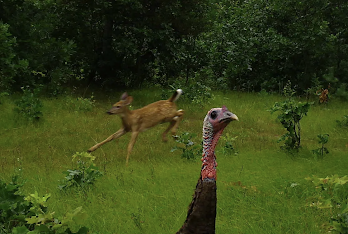 |
| An opossum confronts a deer in a surprise encounter. (Photo via DNR Snapshot Wisconsin) |
 |
| A turkey and a fawn in a close encounter (DNR Snapshot Wisconsin) |
Anthes explains: "Neil Gilbert, a postdoctoral researcher at Michigan State University, and his colleagues analyzed images captured by Snapshot Wisconsin, a citizen-science project run by the Wisconsin Department of Natural Resources. Since 2016, volunteers have deployed more than 2,000 wildlife cameras across the state . . . Wild animals of different species were more likely to lead overlapping lives — appearing at local camera sites in quicker succession — in human-altered landscapes, like farms, than in more undisturbed locations, such as national forests," researchers reported in Proceedings of the National Academy of Sciences.
Anthes notes that human land use
 |
| Not all meetings are interspecies. ((DNR Snapshot Wisconsin) |
"can squeeze animals closer together, increasing the odds that they bump into each other . . . Although more research is needed, that interspecies squeeze could have effects such as making it harder for prey to evade predators, intensifying competition for resources or increasing the risk of interspecies disease transmission, the researchers say." Benjamin Zuckerberg, an ecologist at the University of Wisconsin-Madison and an author of the study, told Anthes in an email, “The compression of species niches will likely lead to new interactions among species with unknown consequences.”
"The cameras, which are triggered by motion and body heat, have captured a menagerie of animals going about their everyday lives: bald eagles scavenging in the snow, bear cubs climbing trees, a newborn fawn, a bevy of otters gamboling down a grassy trail," Athens reports. "The time intervals between detections varied enormously. Sometimes the cameras captured the odd animal couples in the same frame; other times, days or weeks might pass between their appearances. But overall, across all animal pairs, the trend was clear: In relatively pristine habitats, such as national forests, roughly six days elapsed, on average, between detections. In the most human-altered habitats, that interval dropped to an average of four days.
Jennifer Stenglein, a state research scientist, said the study illustrates the potential for using wildlife cameras to probe aspects of animal behavior that might otherwise be difficult to observe.
 |
| Turkeys keep close watch on a sandhill crane. (Photo via DNR Snapshot Wisconsin) |
No comments:
Post a Comment